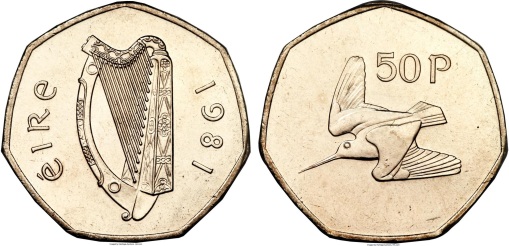Introduction
According to Grace’s Guide – the leading source of historical information on industry and manufacturing in Britain – the King’s Norton Metal Company Limited provided the first competition to the Heaton, or Birmingham Mint when it was also sub-contracted to supply bronze blanks to the Royal Mint in 1912. Unlike the Heaton Mint, it did not strike its own pennies in 1912 – that would come later !
1918 and 1919 (KN) Pennies
In 1918 and 1919, a quantity of pennies were also struck by the King’s Norton Metal Company Limited. These have the letters KN to the left of the date, as their mintmark.

George V Penny 1918-KN MS65 Brown King’s Norton mint, KM-810, S-4053. A conditionally rare World War I emergency issue, struck by the Kings Norton Metal Co., Ltd. to assist the Royal Mint in Penny production. This example has a decent strike for the issue, with iridescent reddish-brown patina.
- Obverse:
- Bare head portrait of King George V to the left
- Engraver: Edgar Bertram MacKennal (BM)
- Legend: GEORGIVS V DEI GRA:BRITT:OMN:REX FID:DEF:IND:IMP:
B.M.
- Bare head portrait of King George V to the left
- Reverse:
- Britannia” right holding trident and shield, sea behind, date underneath exergue line, with KN to left of date.
- “KN” mintmark struck at Kings Norton Metal Co, Birmingham – Sp#4053
- “H” mintmark struck at Ralph Heaton & Sons, Birmingham – Sp#4052
- All other issues struck at Royal Mint, Tower Hill, London – Sp#4051
- Britannia” right holding trident and shield, sea behind, date underneath exergue line, with KN to left of date.
- Mintage:
- 1918 = approx. 3,660,800 (mintage includes both KN and H mintmarks)
- 1919 = approx. 5,209,600 (mintage includes both KN and H mintmarks)
- Specifications:
- Metal alloy = Bronze
- Weight = 9.4g
- Diameter = 31mm
- Thickness = 1.64mm
- Edge = plain
A unique 1919 KN Penny Error
In 1918/1919, the Royal Mint was preoccupied with striking war medals, so sub-contracted work to a factory in Kings Norton, Birmingham, i.e. the production of British pennies. At this time, the Kings Norton Metal Company was producing British West Africa pennies for use in the colonies of Ghana, Nigeria, Sierra Leone and the Gambia.
Apparently, during a production run of British pennies two blanks for British West Africa pennies made it into the batch. When the mistake was realised, allegedly, one was thrown back into the furnace and the other was kept by the engineer – or so the rather unlikely story goes!

This 1919 (KN) British penny, made from a blend of “copper and nickel” instead of bronze (copper and tin), is the only one of its kind.
The copper-nickel coin was then passed to Francis Edward Brown, a local industrialist, and has remained in his family until a divorcee passed it on to her chauffeur. Accompanying the coin is a letter from Mr Brown in which he describes it as a ‘nickel penny – the only one in the world’.
The Royal Mint had verified the coin as original.
“The coin was examined by The Royal Mint in 2000 and they confirm it to be genuine, the specifications of the metal being the same as that of the British West Africa Penny (though that coin when struck had a hole in its centre).“
King’s Norton Metal Company Limited
In 1889, Thomas Richard Bayliss in conjunction with his son, Thomas Abraham Bayliss, founded King’s Norton Metal Co. By 1890 it had been incorporated as a Limited Company and the company was registered on 21 February of that year.
- In 1911 and 1912, the King’s Norton Metal Co supplied bronze blanks for pennies, halfpennies and farthings. As such, they provided the first competition to Birmingham Mint when it was contracted to supply bronze blanks to the Royal Mint
- In 1914 Kings Norton Metal Co struck its first coins for the colonies
- i.e. British West Africa pennies
- for use in the colonies of Ghana, Nigeria, Sierra Leone and the Gambia
- Their main income in 1914 was derived from “Manufacturers of Naval and Military Ammunition, Rolled Metals, Wire. Specialities: Cartridges for Small Arms, Naval and Field Guns, Fuses, Primers, Specialist Metals, e.g. Cupro-Nickel, German Silver, Patent White Metals “Knalba I”, “Knalba II”, Soft Steel.”
1918 Explosives Trades Ltd was formed to merge together the UK explosives industry including Nobel Explosives, G. Kynoch and Co, Curtis’s and Harvey, Eley, Kings Norton Metal Co and Birmingham Metal and Munitions Co.
1920 Name changed to Nobel Industries
1926 Became part of ICI
c.1932 Company closed.
1962 Kings Norton was reorganised as part of Imperial Metal Industries Limited .
The King’s Norton Mint Collection
From an Irish viewpoint, it is perhaps somewhat surprising to see so many Irish pieces featuring in a Heritage Auctions catalogue (CCE Signaure Sale, 17 April 2017). It would appear that the Central Bank of Ireland was sub-contracting some elements of its coin production well after the opening of the Irish Mint at Sandyford, Co Dublin in the mid-1970s, e.g. the production of dies – hence the specimen strikes.

Ireland Republic Specimen Penny 1968 SP66 Red PCGS, KM11. A rare offering as a Specimen, the present offering remains bright with a “freshly struck” appearance.Ex. Kings Norton Mint Collection

Ireland Republic Specimen 50 Pence 1981 SP64 PCGS, Kings Norton Mint, KM24. Rare offering with sharply struck details and glistening surfaces that display splendid eye-appeal to the viewer

Ireland Republic Specimen Penny 1979 SP66 Red, Kings Norton Mint, KM20. Specimens from this series are difficult to find.


